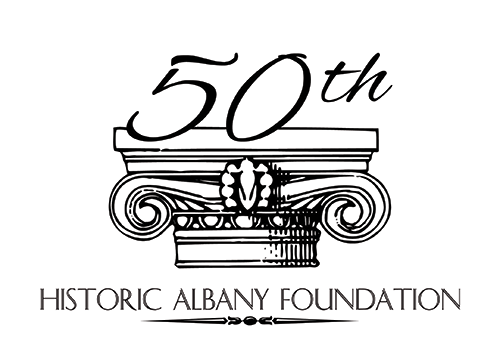Keep up to date with Historic Albany Foundation
Proactive Demolition
/Emergency demolition is something we have long worked against. We are appreciative that the City of Albany has been working toward a proactive and thoughtful approach to emergency demolitions. Two buildings have been identified to be the first proactive demolitions. These buildings have been assessed by an engineer and cost estimates for stabilization and rehabilitation were obtained from an independent contractor. HAF reviewed the buildings to determine if they had any historic or architectural significance.
One of the properties, located on First Street in the West Hill neighborhood, was a long abandoned and neglected home that was causing water leakage and damage to the occupied home next door. It was determined that the best course of action was to take this property down.
On Wednesday, December 18th, staff and volunteers from HAF went to the property and were able to salvage radiators, doors (with their original hardware), a fantastic corner sink, moldings and more.
While Historic Albany Foundation does not condone demolitions in the City of Albany, they still do happen. If there is ever a positive takeaway, it’s having the ability to salvage materials from the home prior to its demise. This defers some of the materials from the landfill, and into our Architectural Parts Warehouse for sale to raise funds to further our mission.
And in this case, working with Rick LaJoy from Code Enforcement and Sam Wells, the City’s Neighborhood Stabilization Coordinator, in a proactive manner has made for the best case of a bad situation. In addition to parts being salvaged, it is expected that the neighbor in the adjoining home is going to purchase the land once it’s vacant, so the empty lot will be cared for and maintained moving forward.
Lastly, it is worth noting that there has not been an emergency demolition in the City of Albany since early November.
Start Reading for our Next Book Club...
/Jan 2022
Our previous book clubs have been such a hit; we imagine this one will be no different. For Spring 2021, we will be partnering with the NYS Writers Institute reading Roscoe by William Kennedy Why not add it to your Christmas list? Shop local at the Book House or use Bookshop.org and choose a local book shop to donate the proceed to.
A Study into Arbor Hill: Introduction
/When I began my internship earlier this year at The Historic Albany Foundation, I wasn't sure what topic my research would be focused on. Albany is full of spectacular architecture, which is one of the reasons I was drawn to the city, and to applying to intern with HAF. Keeping my social justice minor in mind and with my slight knowledge of the history of redlining in Albany, myself and my internship supervisor landed on the area of Arbor Hill. This neighborhood is located in the northeast section of Albany and dates back to the 17th Century. In more recent history, the neighborhood felt the impact of redlining - the now illegal practice of withholding services (financial/healthcare/insurance) from those who lived in ‘hazardous’ areas, often affecting those of racial and ethnic minorities the most acutely.
This brings us to “A Study of Arbor Hill”. I wanted to explore the beginnings of this neighborhood, its 200-year journey to where it is now, and where its future might lie. Arbor Hill has always been an evolving community, from its lumber industry origins to its life as a residential hub. In this series of blogs I want to delve into the wealth of history, buildings, and stories that lie between Clinton Avenue and Tivoli Street.
In my first post, I will begin with Arbor Hill’s origin - originally a sweeping wooded landscape. After the conclusion of the French and Indian War (1754-1763) and the removal of the stockade around Albany, this area’s development began. In 1815 Arbor Hill was officially annexed into Albany city limits, with the Patroon, Stephen Van Rensselaer, granting land from the Dutch government. A prominent family (the Ten Broecks) staked their claim and left a permanent mark on the area with the construction of a mansion. Many others choose to build elaborate homes in a variety of architectural styles close by, these buildings an enduring monument that speaks to the prosperity of the time. The causes of this surge of development? Cose proximity to the prosperous lumber industry, and major water and trading route: the Erie Canal.
“This brings us to “A Study of Arbor Hill”. I wanted to explore the beginnings of this neighborhood, its 200-year journey to where it is now, and where its future might lie….”
Next came the beginning of the Great Migration with thousands of African Americans moving from the rural south to cities in the North of the country to escape discrimination, followed by the Roaring 20s with all its economic prosperity. My second blog will focus on the time period following this: the global catastrophe that was the Great Depression. How would this change the course of Arbor Hill’s development and those who call it home? The steps the Government would take, both in Albany and in cities all around the country, would have a lasting impact for years to come.
I will then discuss the effect of redlining and how it relates to the present life of Arbor Hill, delving into the history of the red and white X placards that pop up in this area and beyond.
Finally, I will explore a few of the building’s stories, ending with a post about the multitude of projects, businesses, and organizations that focus on improving the community in present day.
Join me in my study of Arbor Hill.
By Liliana Surgent






